Entries in Research (23)
Animaris Rhinoceros Mechanism
With a background in science from the University of Delft in Holland, Theo Jansen's kinetic sculptures inspire a sense of wonder at the complexity of nature. For the past 10 years, he has explored the idea of making mechanisms that walk in the wind, ultimately generating a series of "beasts" that rome the beaches living out their own lives. While there are a full series of sculptures, I found the Animaris Rhinoceros sculpture particularly interesting. I decided that I would need to create an interactive digital model of the system to understand the mechanics behind the design. The digital model uses Inverse Kinematics and Bones in 3D Studio Max to create the connections needed for the machine. Essentially, each side of the model is rigged with Inverse Kinematic solvers and then parented to an invisible "Crank" in the middle. By rotating the center crank (named Crank1) around the Y-axis, the system begins to "walk" forwards or backwards depending on the rotation of the crank. Once the initial rig is created, it can be instanced to create the full system as shown in Mr. Jansens actual sculpture.
Download Animaris Rhinoceros.zip (3D Studio Max 9 size: 39k)
Note: This software and its documents are in the public domain and are furnished "as is". The author, Andrew Payne, makes no warranty, expressed or implied, as to the usefulness of the software and documentation for any purpose. This work is licensed under a Creative Commons Attribution-Share Alike 3.0 United States License. http://creativecommons.org/licenses/by-sa/3.0/us/
Johnny Chung Lee - Head Tracking and Interactive Displays
It's been a while since I have seen something that has truly changed the way I look at technology... But a few of the projects designed by Johnny Chung Lee, a Ph.D. graduate student at Carnegie Mellon's Human-Computer Interaction Institute, are quite remarkable in their ingenuity. While many of his projects are applicable becuase of their use of products that are readily available, two projects of his stand above the rest. If you haven't seen these yet, make sure to check out his demonstrations of "Head Tracking for Desktop VR Displays using the Wii Remote" and "Foldable Interactive Displays".
Head Tracking for Desktop VR Displays and other Wii Projects
Projector-Based Location Discovery and Tracking with Foldable Displays
About Johnny Chung Lee
Tensegrity Wall
After a long time coming, I finally decided to continue my research on actuated tensegrity systems. I had already created a fully rigged tensegrity module whose compression member's rotation was driven by the distance from the apex of the system to the midpoint. This distance was wired to a slider in the 3D Max file, so the user can easily drive the system by the use of one simple device. However, to complicate matters a little bit, I decided it would be more interesting to rig these modules up into a system, or a wall type structure where all the modules were connected and thus getting more displacement out of the design. Through a little more math and a lot more time, I was able to create a 4x4 wall system that is fully controlled by the same slider that controls the vertical movement of an actuator inserted in the middle of each module (which would ultimately control the distance from the apex to the midpoint). This system could be configured to work with a sensor so that the structure could change shape according to various environmental stimuli.
Download Tensegrity Wall.zip
Note: This software and its documents are in the public domain and are furnished "as is". The author, Andrew Payne, makes no warranty, expressed or implied, as to the usefulness of the software and documentation for any purpose. This work is licensed under a Creative Commons Attribution-Share Alike 3.0 United States License. http://creativecommons.org/licenses/by-sa/3.0/us/
Responsive Material / Responsive Structure
Make sure you take a look at the lecture given by Sean Hanna at the Subtle Technologies event held at Toronto University. While he readily admits that the manipulation of individual molecules for the production of nano-scale materials is still out of the realm of reality, his focus has been to study micro-structures (at the scale of the millimeter instead of the nanometer) and genetic algorithms in order to create learning materials. His research is readily applicable at other scales as well. Click here to go to the lecture.
Wine Bottle Wall
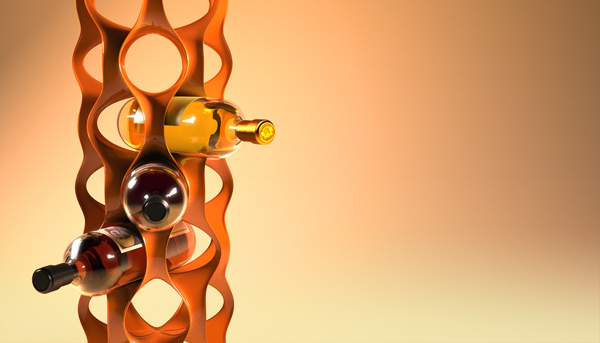
Here is a model I've been working on to develop a wall system that could be digitally fabricated and used to store wine bottles in a unique way. The module, seen on the right, was develped using the Sculpture Generator 1 by Carlos H. Sequin, at UC Berkeley. The modules could be stacked and repeated to form a series of wine rack columns, or duplicated to form a unique wall system.
Stereoscopic Processing
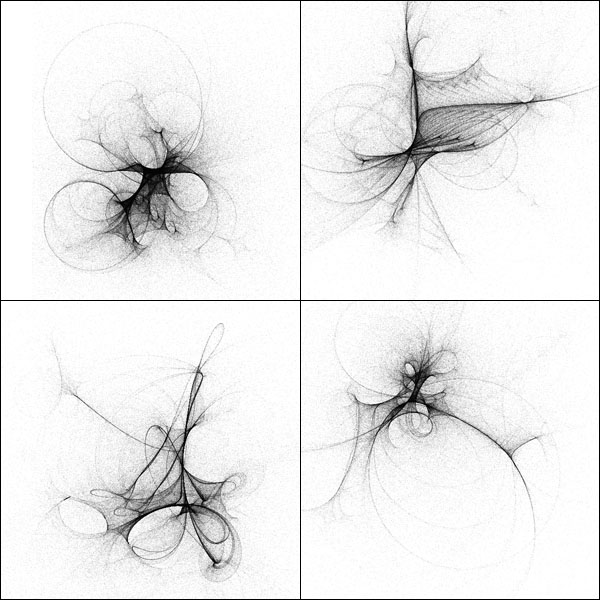
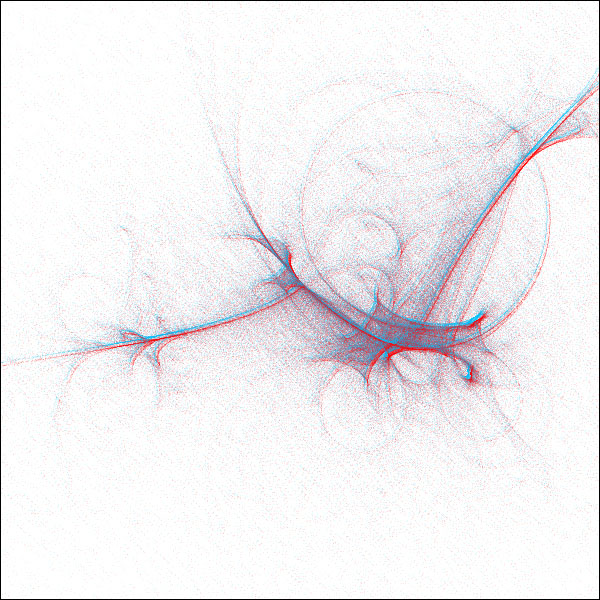
According to Josh Nimoy, The Processing environment is the easiest Java compiler / interactive graphics and multimedia programming environment known to man. The system can be used to produce locally run pieces, as well as web-embeddable Java applets. After doing a little more research on the latest version of Processing, I came across one of the source codes for a drawing applet created by Theo Calvin, who based his code on an example put forth by Jeffery Tarbell. Where I played a part in this research was taking taking the script and adding a few lines of code in order to create a Stereoscopic Image that would give an illusion of surface "depth" when looking at these drawings through 3D glasses. Each drawing can be generated in a matter of seconds.
Adaptive Tensegrity
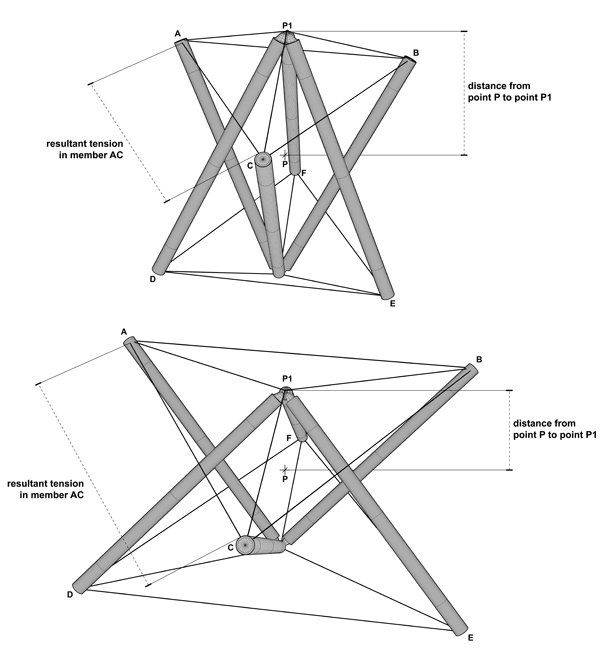
This is a digital model that I created after reading Tristan d'Estree Sterk's essay on actuated tensegrity systems. I've rigged the system to work just like his actuated tensegrity system, so that as the actuator in the middle contracts, the tension members become more rigid, thus making the entire system stronger. The actuated system is one way to create a responsive tensegrity system that can adapt to changing environmental conditions to make a "learning" structure... however you could eliminate the actuator by making the tension members able to expand and contract, much like a muscle. I plan on persuing this line of thought for a future skyscraper, but as yet, is still in a hypothetical stage.
Download Tensegrity Module.zip
Note: This software and its documents are in the public domain and are furnished "as is". The author, Andrew Payne, makes no warranty, expressed or implied, as to the usefulness of the software and documentation for any purpose. This work is licensed under a Creative Commons Attribution-Share Alike 3.0 United States License. http://creativecommons.org/licenses/by-sa/3.0/us/
the[n]projects
This is my entry for the 2005 Miami Biennial Future Possibilies architecture competition where I placed as a semi-finalist. The premise behind the entry is that it was a series of explorations on the idea of the network... So for that I had to define exactly what a network is, which to me has three intrinsic properties: 1) Scale 2) Protocols (the way the network behaves) and 3) Time. So, I created a matrix that would isolate each of these three properties and allow me to combine them in different ways to generate new projects... Since the matrix had 10 slots for each category, you could invariably have up to 3,628,800 different combinations, thus a lot of different network explorations. Becuase the focus of the project was based on the idea of the network, I wanted to create a flash interface that would complement the concept, and have a non-linear "network" navigation system. I'll let you check it out, and play around with the interface and also check out the work, but notice that the different nodes have set attractions, so that as you drag certain rings around the page, the other "like" nodes begin to pull nearer to it, so that they begin over time to collapse into one complete project. Enjoy! Click here for the link: http://www.thenprojects.com
Tensegrity Tower v1.0
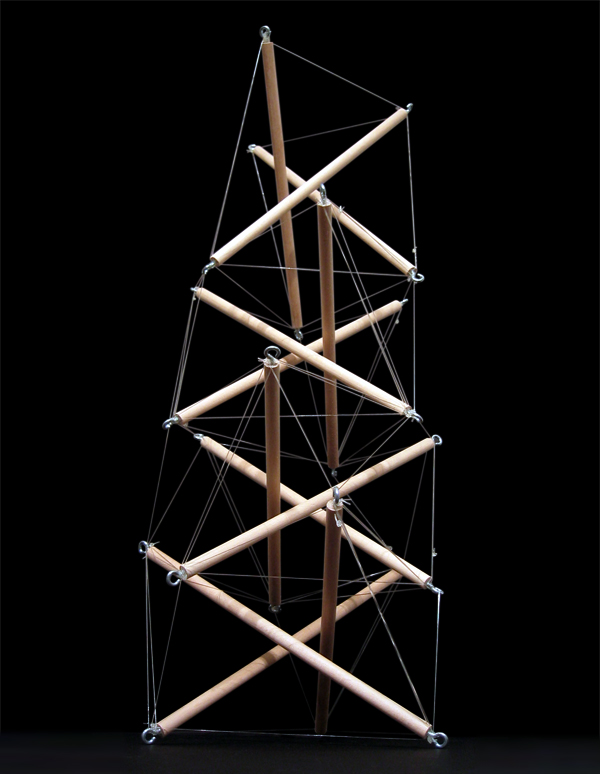
Who knew you could have so much fun with a few wood dowels and a little elastic cord. I created this as a first attempt to figure out how exactly tensegrity structures get assembled and "tuned" via adjusting the elastic cords so that each tension member has the same amount of tension as the others, thus keeping the structure at equilibrium. My next response will hopefully incorporate a responsive system by making the elastic cords out of electropieziolastic materials so that each member can contract or expand via electrical current, thus having a tensegrity system that could adapt to different situations.
Forces Exploded
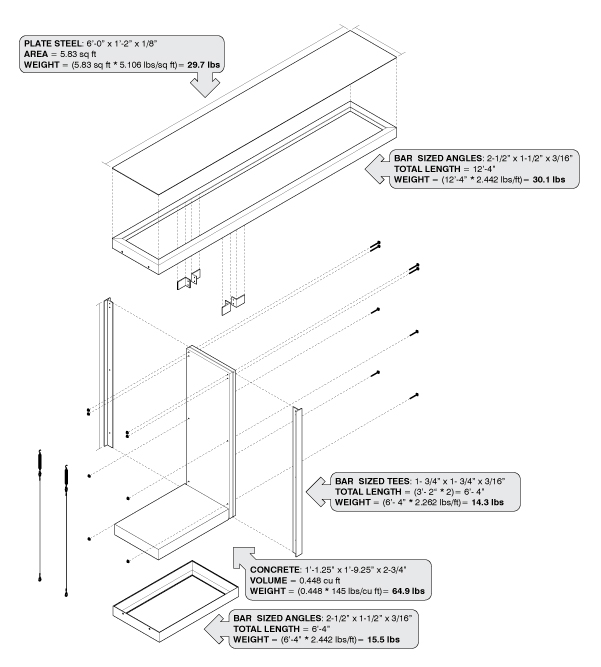
This was the initial force diagram that I created while designing my Cantilever Table, in order to figure out how much weight I needed to counter balance the material weight of the table and the weght of the live loads. My original design called for a pre-cast concrete block to serve as the counter weight (which I did cast, but didn't use) but after solving the forces, I realized that I would need to use 1/4" steel plates instead becuase they were heavier. The overall table weighs about 250 lbs, which I have to agree is a little rediculous, but each piece is made to be bolt connected so that it can be taken apart in smaller assemblages.
Kinematic Pavilion for Transient Passengers
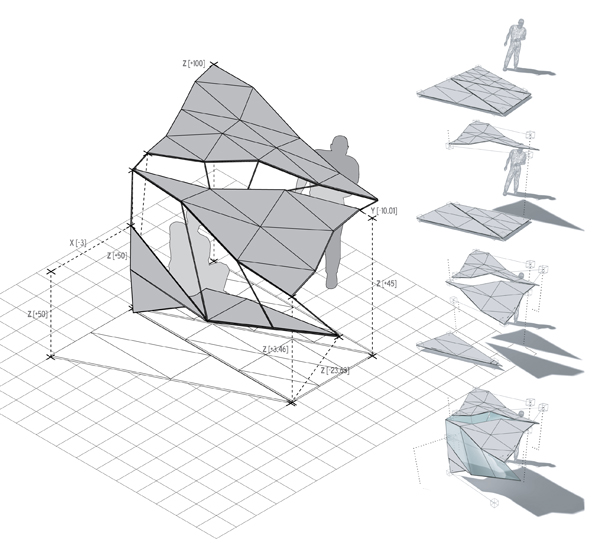
This was a exploration in embedded Inverse Kinematic systems. Each plywood panel has a IK system with 3 nodes embedded into it's surface, so that as each node of the bone structure moves, the panels begin to change into various facetted forms. I then rigged each node's X, Y, and Z values up to sliders in 3D Max so that I could specifically calibrate each node's movement and be able to track that through time. The animation frames on the right show a few still images of the process of erecting this small pavilion that would be utilized by transient passengers.
![[LIFT] architects](/storage/layout/Header_025.png)

